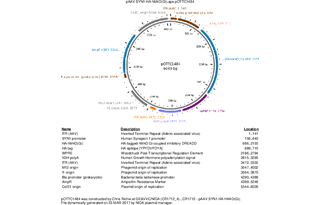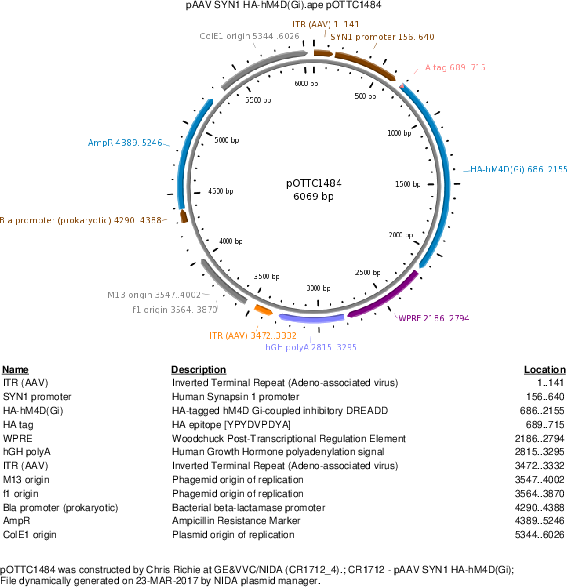pOTTC1484 - pAAV SYN1 HA-hM4D(Gi)
(Plasmid
#121538)
-
PurposeAn adeno-associated viral vector expressing HA-tagged inhibitory DREADD (hM4D(Gi)) from a synapsin promoter
-
Depositing Lab
-
Sequence Information
Ordering
| Item | Catalog # | Description | Quantity | Price (USD) | |
|---|---|---|---|---|---|
| Plasmid | 121538 | Standard format: Plasmid sent in bacteria as agar stab | 1 | $85 | |
| AAV2 | 121538-AAV2 | Virus (100 µL at titer ≥ 7×10¹² vg/mL) and Plasmid. | $405 | ||
| AAV5 | 121538-AAV5 | Virus (100 µL at titer ≥ 7×10¹² vg/mL) and Plasmid. | $405 | ||

Don’t see the serotype you want?
Make a packaging request and we'll get back to you.
Please log in to submit a packaging request.
-
SerotypeSelect serotype for details See details about
-
PricingSelect serotype and quantity $ USD for preparation of µL virus + $30 USD for plasmid.
-
How this works
- Place a request for a quantity of 10 (1 mL), 25 (2.5 mL), or 50 (5 mL). Our all-inclusive pricing includes DNA production and QC.
- Addgene will quickly confirm that we can produce a high-quality prep for you.
- Track your request and place an order from within your account. Payment information must be added before we can begin processing your order.
- Receive your prep in 6–9 weeks after the MTA is approved by your organization.
- Learn more about our Packaged on Request Service.
Backbone
-
Vector backbonepOTTC1479 - pAAV SYN1 iRFP-FLAG
-
Backbone manufacturerNIDA_GEVVC
- Backbone size w/o insert (bp) 4500
- Total vector size (bp) 5571
-
Vector typeMammalian Expression, AAV
Growth in Bacteria
-
Bacterial Resistance(s)Ampicillin, 100 μg/mL
-
Growth Temperature30°C
-
Growth Strain(s)NEB Stable
-
Copy numberLow Copy
Gene/Insert
-
Gene/Insert nameHA-tagged hM4D(Gi)
-
SpeciesH. sapiens (human)
-
Insert Size (bp)1470
-
GenBank ID1132 CHRM4
-
Entrez GeneCHRM4 (a.k.a. HM4, M4R)
- Promoter SYN1
-
Tag
/ Fusion Protein
- HA (N terminal on insert)
Cloning Information
- Cloning method Ligation Independent Cloning
- 5′ sequencing primer hSYN1 F417 ACTCAGCGCTGCCTCAGTCT
- 3′ sequencing primer WPRE R1 ATGAAAGCCATACGGGAAGC (Common Sequencing Primers)
Resource Information
-
Supplemental Documents
-
A portion of this plasmid was derived from a plasmid made byInsert was amplified from pOTTC1329, Addgene 89150
-
Article Citing this Plasmid
Terms and Licenses
-
Academic/Nonprofit Terms
-
Industry Terms
- Not Available to Industry
Trademarks:
- Zeocin® is an InvivoGen trademark.
Information for AAV2 (Catalog # 121538-AAV2) ( Back to top)
Purpose
Ready-to-use AAV2 particles produced from pOTTC1484 - pAAV SYN1 HA-hM4D(Gi) (#121538). In addition to the viral particles, you will also receive purified pOTTC1484 - pAAV SYN1 HA-hM4D(Gi) plasmid DNA.
Synapsin-driven, HA-tagged hM4D(Gi) for neuronal inhibition. These AAV preparations are suitable purity for injection into animals.Delivery
- Volume 100 µL
- Titer ≥ 7×10¹² vg/mL
- Pricing $375 USD for preparation of 100 µL virus + $30 USD for plasmid.
- Storage Store at -80℃. Thaw just before use and keep on ice.
- Shipment Viral particles are shipped frozen on dry ice. Plasmid DNA (≥ 200ng) will also be included in the shipment.
Viral Production & Use
- Packaging Plasmids encode adenoviral helper sequences and AAV rep gene, AAV2 cap gene
- Buffer PBS + 0.001% Poloxamer 188 + 200 mM NaCl
- Serotype AAV2
- Purification Iodixanol gradient ultracentrifugation
- Reporter Gene HA
Biosafety
Requestor is responsible for compliance with their institution's biosafety regulations. Lentivirus is generally considered BSL-2. AAV is generally considered BSL-1, but may require BSL-2 handling depending on the insert. Biosafety Guide
Terms and Licenses
-
Academic/Nonprofit Terms
-
Industry Terms
- Not Available to Industry
Viral Quality Control
- Addgene ensures high quality viral vectors by optimizing and standardizing production protocols and performing rigorous quality control (QC) (see a list of our QC assays). The specific QC assays performed varies for each viral lot. To learn which specific QC assays were performed on your lot, please contact us.
- Titer: the exact titer of your sample will be reported on the tube. The titer you see listed on this page is the guaranteed minimum titer. See how titers are measured.
Visit our viral production page for more information.
Information for AAV5 (Catalog # 121538-AAV5) ( Back to top)
Purpose
Ready-to-use AAV5 particles produced from pOTTC1484 - pAAV SYN1 HA-hM4D(Gi) (#121538). In addition to the viral particles, you will also receive purified pOTTC1484 - pAAV SYN1 HA-hM4D(Gi) plasmid DNA.
Synapsin-driven, HA-tagged hM4D(Gi) for neuronal inhibition. These AAV preparations are suitable purity for injection into animals.Delivery
- Volume 100 µL
- Titer ≥ 7×10¹² vg/mL
- Pricing $375 USD for preparation of 100 µL virus + $30 USD for plasmid.
- Storage Store at -80℃. Thaw just before use and keep on ice.
- Shipment Viral particles are shipped frozen on dry ice. Plasmid DNA (≥ 200ng) will also be included in the shipment.
Viral Production & Use
- Packaging Plasmids encode adenoviral helper sequences and AAV rep gene, AAV5 cap gene
- Buffer PBS + 0.001% Poloxamer 188 + 200 mM NaCl
- Serotype AAV5
- Purification Iodixanol gradient ultracentrifugation
- Reporter Gene HA
Biosafety
Requestor is responsible for compliance with their institution's biosafety regulations. Lentivirus is generally considered BSL-2. AAV is generally considered BSL-1, but may require BSL-2 handling depending on the insert. Biosafety Guide
Terms and Licenses
-
Academic/Nonprofit Terms
-
Industry Terms
- Not Available to Industry
Viral Quality Control
- Addgene ensures high quality viral vectors by optimizing and standardizing production protocols and performing rigorous quality control (QC) (see a list of our QC assays). The specific QC assays performed varies for each viral lot. To learn which specific QC assays were performed on your lot, please contact us.
- Titer: the exact titer of your sample will be reported on the tube. The titer you see listed on this page is the guaranteed minimum titer. See how titers are measured.
Visit our viral production page for more information.
These plasmids were created by your colleagues. Please acknowledge the Principal Investigator, cite the article in which the plasmids were described, and include Addgene in the Materials and Methods of your future publications.
-
For your Materials & Methods section:
pOTTC1484 - pAAV SYN1 HA-hM4D(Gi) was a gift from Christopher Richie (Addgene plasmid # 121538 ; http://n2t.net/addgene:121538 ; RRID:Addgene_121538) For viral preps, please replace (Addgene plasmid # 121538) in the above sentence with: (Addgene viral prep # 121538-AAV2) or (Addgene viral prep # 121538-AAV5) -
For your References section:
Ultrastructural localization of DREADDs in monkeys. Galvan A, Raper J, Hu X, Pare JF, Bonaventura J, Richie CT, Michaelides M, Mueller SAL, Roseboom PH, Oler JA, Kalin NH, Hall RA, Smith Y. Eur J Neurosci. 2019 May 7. doi: 10.1111/ejn.14429. 10.1111/ejn.14429 PubMed 31063250





